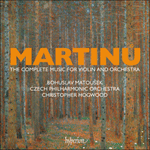
Welcome to Hyperion Records, a British classical label devoted to presenting high-quality recordings of music of all styles and from all periods from the twelfth century to the twenty-first.
Hyperion offers both CDs, and downloads in a number of formats. The site is also available in several languages.
Please use the dropdown buttons to set your preferred options, or use the checkbox to accept the defaults.

The second movement, Andante, is built on a broad cantilena, stylistically very close to the contemporaneous folk-ballet Špalíček H214. Its pendulum-like melodic line is based on the alternation of a central tone with upper and lower notes, mostly at the interval of a fourth.
The closing movement is an Allegretto (although this designation does not appear in the original manuscript and was assigned by the concerto’s editors, the violinist Josef Suk, the conductor Zdenek Košler and the Dvořák scholar Jarmil Burghauser). It starts attacca with a short main thematic cell. As in the first movement this is very short, here consisting of just five notes, with four of them being A (the other note is a B flat), but this time not distributed in different octaves. Melodically, the opening orchestral section continues the Špalíček-like character of the second movement. The entrance of the solo violin, however, with its richly ornamented writing, again bears Dushkin’s stamp. Its simple melodic line is decorated with several appoggiaturas. This is interrupted surprisingly quickly by a series of short solo cadenzas for the violin, and in one of these Martinů combines the solo violin in a highly original way with the snare drum—he returned to this distinctive timbre years later in the last movement of the Suite concertante H276 (also commissioned by Dushkin) as well as in his Phantaisies symphoniques (Symphony No 6) H343.
from notes by Aleš Březina © 2008
Le deuxième mouvement, Andante, repose sur une ample cantilène, stylistiquement fort proche de Špalíček (H214), le ballet populaire composé par Martinů à la même époque. Sa ligne mélodique pendulaire s’appuie sur l’alternance d’une tonalité centrale avec ses notes supérieures et inférieures, essentiellement à une quarte d’intervalle.
Le mouvement conclusif est un Allegretto (même si cette désignation, absente du manuscrit original, fut un ajout de ceux qui préparèrent l’édition du concerto, à savoir le violoniste Josef Suk, le chef d’orchestre Zdenek Košler et le spécialiste de Dvořák Jarmil Burghauser). Il démarre attacca avec la courte cellule thématique principale, toujours aussi brève—elle compte seulement cinq notes, un si bémol et quatre la, cette fois non répartis sur différentes octaves. Mélodiquement, la section orchestrale liminaire perpétue le caractère à la Špalíček du deuxième mouvement. Mais l’entrée du violon solo, à l’écriture richement ornée, porte de nouveau la griffe de Dushkin. Sa ligne mélodique simple, décorée de plusieurs appoggiatures, est étonnamment vite interrompue par une série de courtes cadenzas solo pour le violon, dans l’une desquelles Martinů opère un très original amalgame entre le violon solo et la caisse claire—un timbre singulier qu’il reprendra des années plus tard, dans le dernier mouvement de sa Suite concertante H276 (commandée, elle aussi, par Dushkin) et dans ses Phantaisies symphoniques (Symphonie no 6), H343.
extrait des notes rédigées par Aleš Březina © 2008
Français: Hypérion
Der zweite Satz, Andante, stützt sich auf eine breite Kantilene und steht stilistisch dem ungefähr gleichzeitig entstandenen Ballett im Volkston Špalíček H214 sehr nahe. Die schaukelartige melodische Linie dieser Kantilene beruht auf dem Schwingen zwischen einem zentralen Ton und darüber bzw. darunter liegenden Noten, meistens im Intervallabstand einer Quarte.
Der letzte Satz ist ein Allegretto (auch wenn diese Anweisung nicht in der originalen handschriftlichen Partitur vorkommt, sondern von den Redakteuren des Konzerts, dem Violinisten Josef Suk, dem Dirigenten Zdenek Košler und dem Dvořák-Kenner Jarmil Burghauser hinzugefügt wurde). Dieser Satz folgt attacca auf den vorangegangenen und beginnt mit einer neuen kurzen Hauptthemenzelle. Wie im ersten Satz ist sie sehr kurz. Hier besteht sie aus nur fünf Noten, von denen vier ein A sind (und die übrige Note ein B ist), diesmal nicht auf unterschiedliche Oktaven verteilt. Melodisch setzt der einleitende Orchesterabschnitt mit dem Špalíček-Charakter des zweiten Satzes fort. Der großzügig umrankte Einsatz der Solovioline lässt wiederum den Einfluss Dushkins erkennen. Die einfache melodische Linie wird mit diversen Vorschlägen verziert. Dieser Abschnitt wird überraschend schnell von einer Reihe kurzer Solokadenzen der Violine unterbrochen, und in einer von ihnen kombiniert Martinů die Solovioline auf äußerst originelle Weise mit der kleinen Trommel—er grifft viele Jahre später, im letzten Satz der Suite concertante H276 (ebenfalls ein Auftragswerk von Dushkin) wie auch in seiner Phantaisies symphoniques (Sinfonie Nr. 6) H343, wieder auf diese auffällige Klangfarbe zurück.
aus dem Begleittext von Aleš Březina © 2008
Deutsch: Elke Hockings
 Martinů: The complete music for violin and orchestra Martinů: The complete music for violin and orchestraA four-CD collection of this glorious music, now issued at super-budget price.» More |

